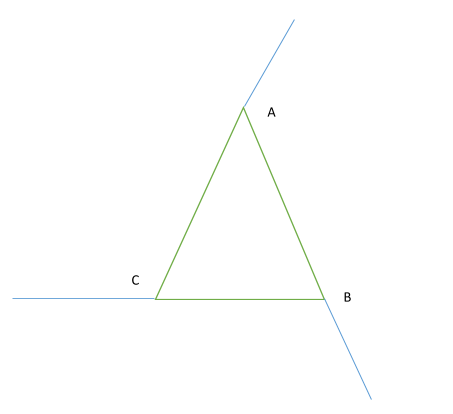
When each side of a triangle is extended in clockwise direction only, the number of exterior angles formed in the triangle is
(A) $4$
(B) $6$
(C) $3$
(D) $8$
Answer
476.7k+ views
Hint: We are given that each side of the triangle is extended in clockwise direction. There are two possible exterior angles for any given vertex on a polygon. One set of exterior angles is formed by extending the sides in counter-clockwise direction and the other set can be prepared by extending each side of the polygon in the opposite direction (clockwise direction). However it does not matter which exterior angles you use because their measurements will be the same on each vertex. We can draw both of the possible exterior angles.
Complete step-by-step answer:
Step1: We will draw a figure and extend its sides in opposite directions (clockwise direction)

Step2: No of apples formed will be equal whether they are formed by extending the side in clockwise direction or in anticlockwise direction in the figure above on extending the lines in opposite directions three exterior angles will be formed.
Final answer: Angles formed are $3$. Hence option (C) is correct.
Additional Information: Let us first learn about what is exterior angle property before we learn about the exterior angle theorem
An exterior angle of a triangle is equal to the angle formed between one side of the triangle and the extension of the adjacent side
Properties of exterior angles:
1. The exterior angle of a given triangle equals the sum of the opposite interior angles of that triangle
2. If an equivalent angle is taken at each vertex of the triangle the exterior angles add to ${360^{^0}}$ in all the case in fact this statement is true for any given convex polygon and not just triangles
Note: In such questions students mainly got confused in clockwise and counterclockwise direction which means clockwise is opposite and counterclockwise is same. They should just kept in mind this thing while drawing or extending the lines
Complete step-by-step answer:
Step1: We will draw a figure and extend its sides in opposite directions (clockwise direction)

Step2: No of apples formed will be equal whether they are formed by extending the side in clockwise direction or in anticlockwise direction in the figure above on extending the lines in opposite directions three exterior angles will be formed.
Final answer: Angles formed are $3$. Hence option (C) is correct.
Additional Information: Let us first learn about what is exterior angle property before we learn about the exterior angle theorem
An exterior angle of a triangle is equal to the angle formed between one side of the triangle and the extension of the adjacent side
Properties of exterior angles:
1. The exterior angle of a given triangle equals the sum of the opposite interior angles of that triangle
2. If an equivalent angle is taken at each vertex of the triangle the exterior angles add to ${360^{^0}}$ in all the case in fact this statement is true for any given convex polygon and not just triangles
Note: In such questions students mainly got confused in clockwise and counterclockwise direction which means clockwise is opposite and counterclockwise is same. They should just kept in mind this thing while drawing or extending the lines
Recently Updated Pages
Master Class 9 General Knowledge: Engaging Questions & Answers for Success

Master Class 9 English: Engaging Questions & Answers for Success

Master Class 9 Science: Engaging Questions & Answers for Success

Master Class 9 Social Science: Engaging Questions & Answers for Success

Master Class 9 Maths: Engaging Questions & Answers for Success

Class 9 Question and Answer - Your Ultimate Solutions Guide

Trending doubts
Fill the blanks with the suitable prepositions 1 The class 9 english CBSE

How do you graph the function fx 4x class 9 maths CBSE

Name the states which share their boundary with Indias class 9 social science CBSE

Difference Between Plant Cell and Animal Cell

What is pollution? How many types of pollution? Define it

What is the color of ferrous sulphate crystals? How does this color change after heating? Name the products formed on strongly heating ferrous sulphate crystals. What type of chemical reaction occurs in this type of change.




